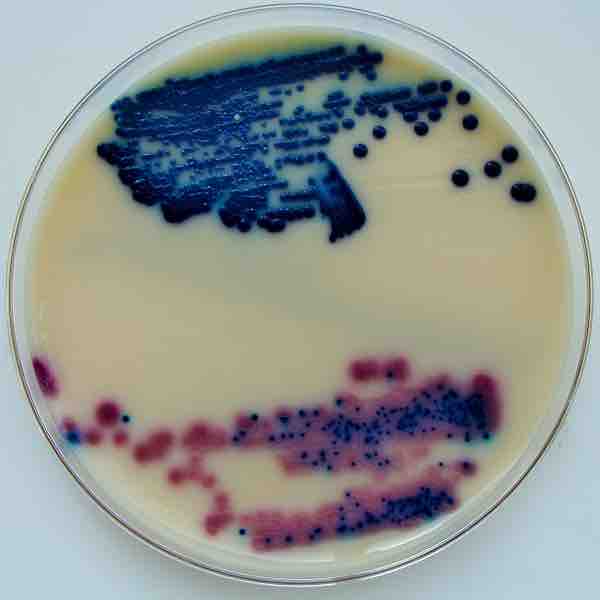Viable Cell Counting
There are a variety of ways to enumerate the number of bacteria in a sample. A viable cell count allows one to identify the number of actively growing/dividing cells in a sample. The plate count method or spread plate relies on bacteria growing a colony on a nutrient medium. The colony becomes visible to the naked eye and the number of colonies on a plate can be counted. To be effective, the dilution of the original sample must be arranged so that on average between 30 and 300 colonies of the target bacterium are grown. Fewer than 30 colonies makes the interpretation statistically unsound and greater than 300 colonies often results in overlapping colonies and imprecision in the count. To ensure that an appropriate number of colonies will be generated several dilutions are normally cultured. The laboratory procedure involves making serial dilutions of the sample (1:10, 1:100, 1:1000 etc. ) in sterile water and cultivating these on nutrient agar in a dish that is sealed and incubated. Typical media include Plate count agar for a general count or MacConkey agar to count gram-negative bacteria such as E. coli. Typically one set of plates is incubated at 22°C and for 24 hours and a second set at 37°C for 24 hours. The composition of the nutrient usually includes reagents that resist the growth of non-target organisms and make the target organism easily identified, often by a color change in the medium . Some recent methods include a fluorescent agent so that counting of the colonies can be automated. At the end of the incubation period the colonies are counted by eye, a procedure that takes a few moments and does not require a microscope as the colonies are typically a few millimeters across.

Selective media can be used to restrict the growth of non-target bacteria.
Urine cultured on Oxoid Brilliance UTI Agar plate. 1uL of urine spread onto the agar surface. The top sample is from patient with clinical urinary tract infection (UTI). The bottom sample is a mixed culture.
The pour plate method is used when the analysis is looking for bacterial species that grow poorly in air. The initial analysis is done by mixing serial dilutions of the sample in liquid nutrient agar which is then poured into bottles. The bottles are then sealed and laid on their sides to produce a sloping agar surface. Colonies that develop in the body of the medium can be counted by eye after incubation. The total number of colonies is referred to as the Total Viable Count (TVC). The unit of measurement is cfu/ml (or colony forming units per milliliter) and relates to the original sample. Calculation of this is a multiple of the counted number of colonies multiplied by the dilution used. Examples of a viable cell count are spread plates from a serial dilution of a liquid culture and pour plates. With a spread plate one makes serial dilutions in liquid media and then spreads a known volume from the last tube in the dilution series. The colonies on the plate can then be counted and the concentration of bacteria in the original culture can be calculated. In the pour plate method a diluted bacterial sample is mixed with melted agar and then that mixture is poured into a petri dish. Again the colonies would be counted and the viable cell count calculated.